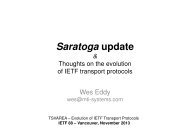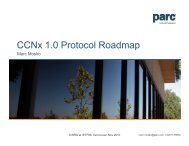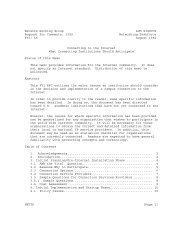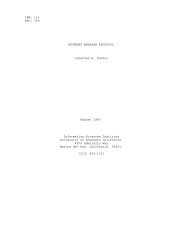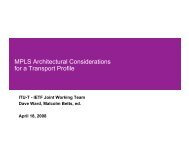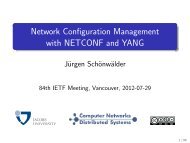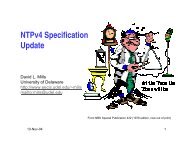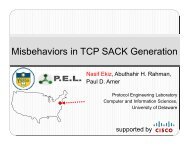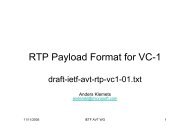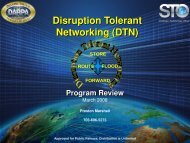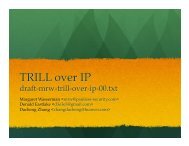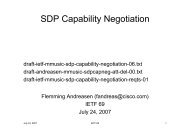Network Working Group J. Postel Request for Comments ... - Faculty
Network Working Group J. Postel Request for Comments ... - Faculty
Network Working Group J. Postel Request for Comments ... - Faculty
You also want an ePaper? Increase the reach of your titles
YUMPU automatically turns print PDFs into web optimized ePapers that Google loves.
<strong>Network</strong> <strong>Working</strong> <strong>Group</strong><br />
<strong>Request</strong> <strong>for</strong> <strong>Comments</strong>: 820<br />
J. <strong>Postel</strong><br />
J. Vernon<br />
January 1983<br />
Obsoletes RFCs: 790, 776, 770, 762,<br />
758, 755, 750, 739, 604, 503, 433, 349<br />
Obsoletes IENs: 127, 117, 93<br />
ASSIGNED NUMBERS<br />
This <strong>Network</strong> <strong>Working</strong> <strong>Group</strong> <strong>Request</strong> <strong>for</strong> <strong>Comments</strong> documents the currently<br />
assigned values from several series of numbers used in network protocol<br />
implementations. This RFC will be updated periodically, and in any case<br />
current in<strong>for</strong>mation can be obtained from Jon <strong>Postel</strong>. The assignment of<br />
numbers is also handled by Jon, subject to the agreement between<br />
DARPA/IPTO and DDN/PMO about number allocation, documented in Appendix A<br />
of this RFC. If you are developing a protocol or application that will<br />
require the use of a link, socket, port, protocol, or network number<br />
please contact Jon to receive a number assignment.<br />
Jon <strong>Postel</strong><br />
USC - In<strong>for</strong>mation Sciences Institute<br />
4676 Admiralty Way<br />
Marina del Rey, Cali<strong>for</strong>nia 90291<br />
phone: (213) 822-1511<br />
ARPANET mail: POSTEL@ISIF<br />
The ARPANET community is making the transition <strong>for</strong>m the ARPANET to the<br />
ARPA Internet. This has been characterized as the NCP/TCP transition<br />
[63], although many other the protocols are involved, too. The working<br />
documents <strong>for</strong> the new Internet environment have been collected by the<br />
<strong>Network</strong> In<strong>for</strong>mation Center (NIC) in a book entitled the "Internet<br />
Protocol Transition Workbook" [62].<br />
Most of the protocols mentioned here are documented in the RFC series of<br />
notes. The more prominent and more generally used are documented in the<br />
"Internet Protocol Transition Workbook" or in the old "Protocol<br />
Handbook" [17] prepared by the NIC. Some of the items listed are<br />
undocumented.<br />
In all cases the name and mailbox of the responsible individual is<br />
indicated. In the lists that follow, a bracketed entry, e.g., [17,iii],<br />
at the right hand margin of the page indicates a reference <strong>for</strong> the<br />
listed protocol, where the number cites the document and the "iii" cites<br />
the person.<br />
<strong>Postel</strong> [Page 1]
RFC 820 January 1983<br />
Assigned Numbers<br />
<strong>Network</strong> Numbers<br />
ASSIGNED NETWORK NUMBERS<br />
The network numbers listed here are used as internet addresses by the<br />
Internet Protocol (IP) [33,62]. The IP uses a 32-bit address field<br />
and divides that address into a network part and a "rest" or local<br />
address part. The division takes 3 <strong>for</strong>ms or classes.<br />
The first type of address, or class A, has a 7-bit network number<br />
and a 24-bit local address. The highest-order bit is set to 0.<br />
This allows 128 class A networks.<br />
1 2 3<br />
0 1 2 3 4 5 6 7 8 9 0 1 2 3 4 5 6 7 8 9 0 1 2 3 4 5 6 7 8 9 0 1<br />
+-+-+-+-+-+-+-+-+-+-+-+-+-+-+-+-+-+-+-+-+-+-+-+-+-+-+-+-+-+-+-+-+<br />
|0| NETWORK | Local Address |<br />
+-+-+-+-+-+-+-+-+-+-+-+-+-+-+-+-+-+-+-+-+-+-+-+-+-+-+-+-+-+-+-+-+<br />
Class A Address<br />
The second type of address, class B, has a 14-bit network number<br />
and a 16-bit local address. The two highest-order bits are set to<br />
1-0. This allows 16,384 class B networks.<br />
1 2 3<br />
0 1 2 3 4 5 6 7 8 9 0 1 2 3 4 5 6 7 8 9 0 1 2 3 4 5 6 7 8 9 0 1<br />
+-+-+-+-+-+-+-+-+-+-+-+-+-+-+-+-+-+-+-+-+-+-+-+-+-+-+-+-+-+-+-+-+<br />
|1 0| NETWORK | Local Address |<br />
+-+-+-+-+-+-+-+-+-+-+-+-+-+-+-+-+-+-+-+-+-+-+-+-+-+-+-+-+-+-+-+-+<br />
Class B Address<br />
The third type of address, class C, has a 21-bit network number<br />
and a 8-bit local address. The three highest-order bits are set<br />
to 1-0-0. This allows 2,097,152 class C networks.<br />
1 2 3<br />
0 1 2 3 4 5 6 7 8 9 0 1 2 3 4 5 6 7 8 9 0 1 2 3 4 5 6 7 8 9 0 1<br />
+-+-+-+-+-+-+-+-+-+-+-+-+-+-+-+-+-+-+-+-+-+-+-+-+-+-+-+-+-+-+-+-+<br />
|1 1 0| NETWORK | Local Address |<br />
+-+-+-+-+-+-+-+-+-+-+-+-+-+-+-+-+-+-+-+-+-+-+-+-+-+-+-+-+-+-+-+-+<br />
Class C Address<br />
One commonly used notation <strong>for</strong> internet host addresses divides the<br />
32-bit address into four 8-bit fields and specifies the value of each<br />
field as a decimal number with the fields separated by periods. This<br />
is called the "dotted decimal" notation. For example, the internet<br />
address of ISIF in dotted decimal is 010.002.000.052, or 10.2.0.52.<br />
<strong>Postel</strong> [Page 2]
RFC 820 January 1983<br />
Assigned Numbers<br />
<strong>Network</strong> Numbers<br />
The dotted decimal notation will be used in the listing of assigned<br />
network numbers. The class A networks will have nnn.rrr.rrr.rrr, the<br />
class B networks will have nnn.nnn.rrr.rrr, and the class C networks<br />
will have nnn.nnn.nnn.rrr, where nnn represents part or all of a<br />
network number and rrr represents part or all of a local address or<br />
rest field.<br />
For various reasons, the assigned numbers of networks are sometimes<br />
changed. To ease the transition the old number will be listed as<br />
well. These "old number" entries will be marked with a "T" following<br />
the number and preceeding the name.<br />
To reflect the allocation of network identifiers among various<br />
categories (see Appendix A), a one-character code is placed to the<br />
left of the network number (in the column marked by an asterisk): R<br />
<strong>for</strong> Research and Development, D <strong>for</strong> DoD, and C <strong>for</strong> Commercial.<br />
Assigned <strong>Network</strong> Numbers<br />
Class A <strong>Network</strong>s<br />
* Internet Address Name <strong>Network</strong> References<br />
---------------- ---- ------- ----------<br />
000.rrr.rrr.rrr Reserved [JBP]<br />
R 001.rrr.rrr.rrr T BBN-PR BBN Packet Radio <strong>Network</strong> [JAW3]<br />
R 002.rrr.rrr.rrr T SF-PR-1 SF-1 Packet Radio <strong>Network</strong> [JEM]<br />
R 003.rrr.rrr.rrr RCC-NET BBN RCC <strong>Network</strong> [JGH]<br />
R 004.rrr.rrr.rrr SATNET Atlantic Satellite <strong>Network</strong>[DM11]<br />
D 005.rrr.rrr.rrr T DEMO-PR-1 Demo-1 Packet Radio <strong>Network</strong>[LCS]<br />
R 006.rrr.rrr.rrr T SF-PR-2 SF-2 Packet Radio <strong>Network</strong> [JEM]<br />
007.rrr.rrr.rrr Unassigned [JBP]<br />
R 008.rrr.rrr.rrr BBN-NET BBN <strong>Network</strong> [JGH]<br />
D 009.rrr.rrr.rrr T BRAGG-PR Ft. Bragg Packet Radio Net [JEM]<br />
R 010.rrr.rrr.rrr ARPANET ARPANET [17,1,REK2]<br />
R 011.rrr.rrr.rrr T UCLNET University College London [PK]<br />
012.rrr.rrr.rrr Unassigned [JBP]<br />
013.rrr.rrr.rrr Unassigned [JBP]<br />
C 014.rrr.rrr.rrr PDN Public Data <strong>Network</strong> [REK2]<br />
015.rrr.rrr.rrr Unassigned [JBP]<br />
016.rrr.rrr.rrr Unassigned [JBP]<br />
017.rrr.rrr.rrr Unassigned [JBP]<br />
R 018.rrr.rrr.rrr MIT MIT <strong>Network</strong> [10,43,NC3]<br />
019.rrr.rrr.rrr Unassigned [JBP]<br />
020.rrr.rrr.rrr Unassigned [JBP]<br />
D 021.rrr.rrr.rrr EDN DCEC EDN [EC5]<br />
022.rrr.rrr.rrr Unassigned [JBP]<br />
R 023.rrr.rrr.rrr MITRE MITRE Cablenet [44,APS]<br />
024.rrr.rrr.rrr Unassigned [JBP]<br />
<strong>Postel</strong> [Page 3]
RFC 820 January 1983<br />
Assigned Numbers<br />
<strong>Network</strong> Numbers<br />
R 025.rrr.rrr.rrr RSRE-PPSN RSRE / PPSN [NM]<br />
D 026.rrr.rrr.rrr MILNET MILNET [HH6]<br />
R 027.rrr.rrr.rrr NOSC-LCCN NOSC / LCCN [KTP]<br />
R 028.rrr.rrr.rrr WIDEBAND Wide Band Satellite Net [CJW2]<br />
029.rrr.rrr.rrr Unassigned [JBP]<br />
R 030.rrr.rrr.rrr DCN-UCL UCL DCNET [PK]<br />
031.rrr.rrr.rrr Unassigned [JBP]<br />
R 032.rrr.rrr.rrr UCL-TAC UCL TAC [PK]<br />
033.rrr.rrr.rrr Unassigned [JBP]<br />
034.rrr.rrr.rrr Unassigned [JBP]<br />
R 035.rrr.rrr.rrr RSRE-NULL RSRE Null <strong>Network</strong> [NM]<br />
R 036.rrr.rrr.rrr T SU-NET Stan<strong>for</strong>d University <strong>Network</strong>[JCM]<br />
037.rrr.rrr.rrr Unassigned [JBP]<br />
038.rrr.rrr.rrr Unassigned [JBP]<br />
R 039.rrr.rrr.rrr SRINET SRI Local <strong>Network</strong> [GEOF]<br />
040.rrr.rrr.rrr Unassigned [JBP]<br />
R 041.rrr.rrr.rrr BBN-LN-TEST BBN Local <strong>Network</strong> Testbed [KTP]<br />
042.rrr.rrr.rrr Unassigned [JBP]<br />
043.rrr.rrr.rrr Unassigned [JBP]<br />
R 044.rrr.rrr.rrr AMPRNET Amateur Radio Experiment Net[HM]<br />
R 045.rrr.rrr.rrr T C3-PR<br />
Testbed Development PRNET [BG5]<br />
R 046.rrr.rrr.rrr UCB-ETHER UC Berkeley Ethernet [SXL]<br />
R 047.rrr.rrr.rrr T SAC-PR SAC Packet Radio <strong>Network</strong> [BG5]<br />
R 048.rrr.rrr.rrr NDRE-TIU NDRE-TIU [PS3]<br />
049.rrr.rrr.rrr Unassigned [JBP]<br />
R 050.rrr.rrr.rrr NDRE-RING NDRE-RING [PS3]<br />
051.rrr.rrr.rrr Unassigned [JBP]<br />
R 052.rrr.rrr.rrr T ROCKWELL-PR Rockwell Packet Radio Net [EHP]<br />
053.rrr.rrr.rrr-126.rrr.rrr.rrr Unassigned<br />
[JBP]<br />
127.rrr.rrr.rrr Reserved [JBP]<br />
Class B <strong>Network</strong>s<br />
* Internet Address Name <strong>Network</strong> References<br />
---------------- ---- ------- ----------<br />
128.000.rrr.rrr Reserved [JBP]<br />
R 128.001.rrr.rrr BBN-TEST-B BBN-GATE-TEST-B [RH6]<br />
R 128.002.rrr.rrr CMU-NET CMU-Ethernet [HDW2]<br />
R 128.003.rrr.rrr LBL-CSAM LBL-CSAM-RESEARCH [MO1]<br />
R 128.004.rrr.rrr DCNET LINKABIT DCNET [DLM1]<br />
R 128.005.rrr.rrr FORDNET FORD DCNET [DLM1]<br />
R 128.006.rrr.rrr RUTGERS RUTGERS [CLH3]<br />
R 128.007.rrr.rrr DFVLR DFVLR DCNET <strong>Network</strong> [HDC1]<br />
R 128.008.rrr.rrr UMDNET Univ of Maryland DCNET [DLM1]<br />
R 128.009.rrr.rrr ISI-NET ISI Local <strong>Network</strong> [CMR]<br />
R 128.010.rrr.rrr PURDUE-CS Purdue Computer Science [CXK]<br />
R 128.011.rrr.rrr BBN-CRONUS BBN DOS Project [12,WIM]<br />
R 128.012.rrr.rrr SU-NET Stan<strong>for</strong>d University Net [JCM]<br />
<strong>Postel</strong> [Page 4]
RFC 820 January 1983<br />
Assigned Numbers<br />
<strong>Network</strong> Numbers<br />
D 128.013.rrr.rrr MATNET Mobile Access Terminal Net[DM11]<br />
R 128.014.rrr.rrr BBN-SAT-TEST BBN SATNET Test Net [DM11]<br />
R 128.015.rrr.rrr S1NET LLL-S1-NET [EAK1]<br />
R 128.016.rrr.rrr UCLNET University College London [PK]<br />
128.017.rrr.rrr Unassigned [JBP]<br />
128.018.rrr.rrr Unassigned [JBP]<br />
128.019.rrr.rrr Unassigned [JBP]<br />
128.020.rrr.rrr Unassigned [JBP]<br />
R 128.021.rrr.rrr SF-PR-1 SF-1 Packet Radio <strong>Network</strong> [JEM]<br />
R 128.022.rrr.rrr SF-PR-2 SF-2 Packet Radio <strong>Network</strong> [JEM]<br />
R 128.023.rrr.rrr BBN-PR BBN Packet Radio <strong>Network</strong> [JAW3]<br />
R 128.024.rrr.rrr ROCKWELL-PR Rockwell Packet Radio Net [EHP]<br />
D 128.025.rrr.rrr BRAGG-PR Ft. Bragg Packet Radio Net [JEM]<br />
D 128.026.rrr.rrr SAC-PR SAC Packet Radio <strong>Network</strong> [BG5]<br />
D 128.027.rrr.rrr DEMO-PR-1 Demo-1 Packet Radio <strong>Network</strong>[LCS]<br />
D 128.028.rrr.rrr C3-PR Testbed Development PR NET [BG5]<br />
128.029.rrr.rrr-191.254.rrr.rrr Unassigned<br />
[JBP]<br />
191.255.rrr.rrr Reserved [JBP]<br />
Class C <strong>Network</strong>s<br />
* Internet Address Name <strong>Network</strong> References<br />
---------------- ---- ------- ----------<br />
192.000.000.rrr Reserved [JBP]<br />
R 192.000.001.rrr BBN-TEST-C BBN-GATE-TEST-C [RH6]<br />
192.000.002.rrr-192.000.255.rrr Unassigned<br />
[JBP]<br />
R 192.001.xxx.rrr-192.004.xxx.rrr BBN local networks<br />
[SGC]<br />
R 192.005.001.rrr CISLNET CISL Multics <strong>Network</strong> [CH2]<br />
R 192.005.002.rrr WISC Univ of Wisconsin Madison [RS23]<br />
C 192.005.003.rrr HP-DESIGN-AIDS HP Design Aids [NXK]<br />
C 192.005.004.rrr HP-TCG-UNIX Hewlett Packard TCG Unix [NXK]<br />
D 192.005.005.rrr BRLNET BRLNET [1,MJM2]<br />
D 192.005.006.rrr MINET MINET [1,DHH]<br />
R 192.005.007.rrr CIT-CS-NET Caltech-CS-Net [65,DSW]<br />
R 192.005.008.rrr WASHINGTON University of Washington [JAR4]<br />
R 192.005.009.rrr AERONET Aerospace Labnet [9,LCN]<br />
R 192.005.010.rrr ECLNET USC-ECL-CAMPUS-NET [MXB]<br />
R 192.005.011.rrr CSS-RING SEISMIC-RESEARCH-NET [RR2]<br />
R 192.005.012.rrr UTAH-NET UTAH-COMPUTER-SCIENCE-NET [RF1]<br />
192.005.013.rrr Unassigned [JBP]<br />
192.005.014.rrr Unassigned [JBP]<br />
192.005.015.rrr Unassigned [JBP]<br />
192.005.016.rrr Unassigned [JBP]<br />
192.005.017.rrr Unassigned [JBP]<br />
192.005.018.rrr Unassigned [JBP]<br />
192.005.019.rrr Unassigned [JBP]<br />
192.005.020.rrr Unassigned [JBP]<br />
D 192.005.021.rrr BRLNET1 BRLNET1 [1,MJM2]<br />
<strong>Postel</strong> [Page 5]
RFC 820 January 1983<br />
Assigned Numbers<br />
<strong>Network</strong> Numbers<br />
D 192.005.022.rrr BRLNET2 BRLNET2 [1,MJM2]<br />
D 192.005.022.rrr BRLNET3 BRLNET3 [1,MJM2]<br />
D 192.005.022.rrr BRLNET4 BRLNET4 [1,MJM2]<br />
D 192.005.022.rrr BRLNET5 BRLNET54 [1,MJM2]<br />
192.005.026.rrr-223.255.254.rrr Unassigned<br />
[JBP]<br />
223.255.255.rrr Reserved [JBP]<br />
Other Reserved Internet Addresses<br />
Internet Address Name <strong>Network</strong> References<br />
---------------- ---- ------- ----------<br />
224.000.000.000-255.255.255.255 Reserved [JBP]<br />
<strong>Network</strong> Totals<br />
Assigned<br />
Class A B C Total<br />
Research 26 19 1033 1078<br />
Defense 4 5 7 16<br />
Commercial 1 0 2 3<br />
Total 31 24 1042 1097<br />
Maximum Allowed<br />
Class A B C Total<br />
Research 8 1024 65536 66568<br />
Defense 24 3072 458752 461848<br />
Commercial 94 12286 1572862 1585242<br />
Total 126 16382 2097150 2113658<br />
<strong>Postel</strong> [Page 6]
RFC 820 January 1983<br />
Assigned Numbers<br />
Internet Version Numbers<br />
ASSIGNED INTERNET VERSION NUMBERS<br />
In the Internet Protocol (IP) [33,62] there is a field to identify<br />
the version of the internetwork general protocol. This field is 4<br />
bits in size.<br />
Assigned Internet Version Numbers<br />
Decimal Octal Version References<br />
------- ----- ------- ----------<br />
0 0 Reserved [JBP]<br />
1-3 1-3 Unassigned [JBP]<br />
4 4 Internet Protocol [33,62,JBP]<br />
5 5 ST Datagram Mode [20,JWF]<br />
6-14 6-16 Unassigned [JBP]<br />
15 17 Reserved [JBP]<br />
ASSIGNED INTERNET PROTOCOL NUMBERS<br />
In the Internet Protocol (IP) [33,62] there is a field, called<br />
Protocol, to identify the the next level protocol. This is an 8 bit<br />
field.<br />
Assigned Internet Protocol Numbers<br />
Decimal Octal Protocol References<br />
------- ----- ---------------- ----------<br />
0 0 Reserved [JBP]<br />
1 1 ICMP [53,62,JBP]<br />
2 2 Unassigned [JBP]<br />
3 3 Gateway-to-Gateway [48,49,JFH2]<br />
4 4 CMCC Gateway Monitoring Message [18,19,MB]<br />
5 5 Stream (ST) [20,JWF]<br />
6 6 Transmission Control (TCP) [34,62,JBP]<br />
7 7 UCL [PK]<br />
8 10 Exterior Gateway Protocol (EGP) [66,RH6]<br />
9 11 Unassigned [JBP]<br />
10 12 BBN RCC Monitoring [SGC]<br />
11 13 NVP [12,SC3]<br />
12 14 PUP [4,EAT3]<br />
13-14 15-16 Unassigned [JBP]<br />
15 17 Cross Net Debugger (XNET) [25,JFH2]<br />
16 20 Chaos Stream [NC3]<br />
17 21 User Datagram (UDP) [42,62,JBP]<br />
18 22 Multiplexing [13,JBP]<br />
19 23 DCN Measurement Subsystems [DLM1]<br />
20 24 Host Monitoring (HMP) [55,RH6]<br />
21 25 Packet Radio Measurement [ZSU]<br />
<strong>Postel</strong> [Page 7]
RFC 820 January 1983<br />
Assigned Numbers<br />
Internet Protocol Numbers<br />
22 26 XEROX NS IP [59,JBP]<br />
23 27 Trunk-1 [BML]<br />
24 30 Trunk-2 [BML]<br />
25-60 31-74 Unassigned [JBP]<br />
61 75 any host internal protocol [JBP]<br />
62 76 CFTP [60,HCF2]<br />
63 77 any local network [JBP]<br />
64 100 SATNET and Backroom EXPAK [DM11]<br />
65 101 MIT Subnet Support [NC3]<br />
66 102 MIT VAX Remote Disk Protocol [MBG]<br />
67 103 Internet Pluribus Packet Core [DM11]<br />
68 104 Unassigned [JBP]<br />
69 105 SATNET Monitoring [DM11]<br />
70 106 Unassigned [JBP]<br />
71 107 Internet Packet Core Utility [DM11]<br />
72-75 110-113 Unassigned [JBP]<br />
76 114 Backroom SATNET Monitoring [DM11]<br />
77 115 Unassigned [JBP]<br />
78 116 WIDEBAND Monitoring [DM11]<br />
79 117 WIDEBAND EXPAK [DM11]<br />
80-254 120-376 Unassigned [JBP]<br />
255 377 Reserved [JBP]<br />
<strong>Postel</strong> [Page 8]
RFC 820 January 1983<br />
Assigned Numbers<br />
Port Numbers<br />
ASSIGNED PORT NUMBERS<br />
Ports are used in the TCP [34,62] to name the ends of logical<br />
connections which carry long term conversations. For the purpose of<br />
providing services to unknown callers a service contact port is<br />
defined. This list specifies the port used by the server process as<br />
its contact port. The contact port is sometimes called the<br />
"well-known port".<br />
To the extent possible these same port assignments are used with<br />
UDP [42,62].<br />
The assigned ports use a small portion of the possible port numbers.<br />
The assigned ports have all except the low order eight bits cleared<br />
to zero. The low order eight bits are specified here.<br />
Port Assignments:<br />
Decimal Octal Description References<br />
------- ----- ----------- ----------<br />
1 1 Old Telnet [40,JBP]<br />
3 3 Old File Transfer [27,11,24,JBP]<br />
5 5 Remote Job Entry [6,17,JBP]<br />
7 7 Echo [35,JBP]<br />
9 11 Discard [32,JBP]<br />
11 13 Who is on or SYSTAT [JBP]<br />
13 15 Date and Time [JBP]<br />
15 17 Who is up or NETSTAT [JBP]<br />
17 21 Short Text Message [JBP]<br />
19 23 Character generator or TTYTST [31,JBP]<br />
20 24 File Transfer (Default Data) [36,62,JBP]<br />
21 25 File Transfer (Control) [36,62,JBP]<br />
23 27 Telnet [41,62,JBP]<br />
25 31 SMTP [54,62,JBP]<br />
27 33 NSW User System FE [14,RHT]<br />
29 35 MSG ICP [29,RHT]<br />
31 37 MSG Authentication [29,RHT]<br />
33 41 Unassigned [JBP]<br />
35 43 IO Station Spooler [JBP]<br />
37 45 Time Server [22,JBP]<br />
39 47 Unassigned [JBP]<br />
41 51 Graphics [46,17,JBP]<br />
42 52 Name Server [38,62,JBP]<br />
43 53 WhoIs [57,62,JAKE]<br />
45 55 Message Processing Module (receive) [37,JBP]<br />
46 56 MPM (default send) [37,JBP]<br />
47 57 NI FTP [50,SK]<br />
49-53 61-65 Unassigned [JBP]<br />
<strong>Postel</strong> [Page 9]
RFC 820 January 1983<br />
Assigned Numbers<br />
Port Numbers<br />
55 67 ISI Graphics Language [3,RB6]<br />
57 71 Unassigned [JBP]<br />
59 73 Augment File Mover [WWB]<br />
61 75 NIMAIL [56,SK]<br />
63 77 Unassigned [JBP]<br />
65 101 Unassigned [JBP]<br />
67 103 Datacomputer at CCA [8,JZS]<br />
69 105 Trivial File Transfer [47,62,KRS]<br />
71 107 NETRJS [5,17,RTB]<br />
72 110 NETRJS [5,17,RTB]<br />
73 111 NETRJS [5,17,RTB]<br />
74 112 NETRJS [5,17,RTB]<br />
75 113 Unassigned [JBP]<br />
77 115 any private RJE server [JBP]<br />
79 117 Name or Finger [23,17,KLH]<br />
81 121 HOSTS2 Name Server [EAK1]<br />
83 123 MIT ML Device [DPR]<br />
85 125 MIT ML Device [DPR]<br />
87 127 any terminal link [JBP]<br />
89 131 SU/MIT Telnet Gateway [MRC]<br />
91 133 MIT Dover Spooler [EBM]<br />
93 135 Device Control Protocol [DCT]<br />
95 137 SUPDUP [15,MRC]<br />
97 141 Datacomputer Status [8,JZS]<br />
99 143 Metagram Relay [GEOF]<br />
101 145 NIC Host Name Server [64,62,JAKE]<br />
103 147 CSNET Mailbox Name Server (Telnet) [58,MHS1]<br />
105 151 CSNET Mailbox Name Server (Program) [58,MHS1]<br />
107 153 Remote Telnet Service [61,JBP]<br />
109-129 155-201 Unassigned [JBP]<br />
131 203 Datacomputer [8,JZS]<br />
132-223 204-337 Reserved [JBP]<br />
224-241 340-361 Unassigned [JBP]<br />
243 363 Survey Measurement [2,AV]<br />
245 365 LINK [7,RDB2]<br />
247-255 367-377 Unassigned [JBP]<br />
<strong>Postel</strong> [Page 10]
RFC 820 January 1983<br />
Assigned Numbers<br />
Autonomous System Numbers<br />
ASSIGNED AUTONOMOUS SYSTEM NUMBERS<br />
The Exterior Gateway Protocol (EGP) [66] specifies that groups of<br />
gateways may <strong>for</strong> autonomous systems. The EGP provides a 16-bit field<br />
<strong>for</strong> identifying such systems. The values of this field are<br />
registered here.<br />
Autonomous System Numbers:<br />
Decimal Description References<br />
------- ----------- ----------<br />
0 Reserved [JBP]<br />
1 The BBN Gateways [JBP]<br />
2-65534 Unassigned [JBP]<br />
65535 Reserved [JBP]<br />
ASSIGNED ARPANET LINK NUMBERS<br />
The word "link" here refers to a field in the original ARPANET<br />
Host/IMP interface leader. The link was originally defined as an 8<br />
bit field. Some time after the ARPANET Host-to-Host (AHHP) protocol<br />
was defined and, by now some years ago, the definition of this field<br />
was changed to "Message-ID" and the length to 12 bits. The name link<br />
now refers to the high order 8 bits of this 12 bit message-id field.<br />
The low order 4 bits of the message-id field are to be zero unless<br />
specifically specified otherwise <strong>for</strong> the particular protocol used on<br />
that link. The Host/IMP interface is defined in BBN report 1822 [1].<br />
Link Assignments:<br />
Decimal Octal Description References<br />
------- ----- ----------- ----------<br />
0 0 AHHP Control Messages [28,17,JBP]<br />
1 1 Reserved [JBP]<br />
2-71 2-107 AHHP Regular Messages [28,17,JBP]<br />
72-149 110-225 Reserved [JBP]<br />
150 226 Xerox NS IP [59,LLG]<br />
151 227 Unassigned [JBP]<br />
152 230 PARC Universal Protocol [4,EAT3]<br />
153 231 TIP Status Reporting [JGH]<br />
154 232 TIP Accounting [JGH]<br />
155 233 Internet Protocol (regular) [33,62,JBP]<br />
156-158 234-236 Internet Protocol (experimental) [33,62,JBP]<br />
159-195 237-303 Unassigned [JBP]<br />
196-255 304-377 Experimental Protocols [JBP]<br />
248-255 370-377 <strong>Network</strong> Maintenance [JGH]<br />
<strong>Postel</strong> [Page 11]
RFC 820 January 1983<br />
Assigned Numbers<br />
Ethernet Numbers of Interest<br />
ETHERNET NUMBERS OF INTEREST<br />
Many of the networks of all classes are Ethernets (10Mb) or<br />
Experimental Ethernets (3Mb). These systems use a message "type"<br />
field in much the same way the ARPANET uses the "link" field.<br />
Assignments:<br />
Ethernet Exp. Ethernet Description References<br />
-------------- -------------- ----------- ----------<br />
decimal Hex decimal octal<br />
512 02,00 512 1000 XEROX PUP [4,EAT3]<br />
1536 06,00 1536 3000 XEROX NS IDP [59,LLG]<br />
2048 08,00 513 1001 DOD IP [33,62,JBP]<br />
2054 08,06 - - Address Res [67,DCP1]<br />
ASSIGNED PUBLIC DATA NETWORK NUMBERS<br />
One of the Internet Class A <strong>Network</strong>s is the international system of<br />
Public Data <strong>Network</strong>s. This section lists the mapping between the<br />
Internet Addresses and the Public Data <strong>Network</strong> Addresses.<br />
Assignments:<br />
Internet Public Data Net Description References<br />
--------------- --------------- ----------- ----------<br />
014.000.000.000 Reserved [JBP]<br />
014.000.000.001 311031700035 00 PURDUE-TN [CXK]<br />
014.000.000.002 311060800027 00 UWISC-TN [CXK]<br />
014.000.000.003 311030200024 00 UDEL-TN [CXK]<br />
014.000.000.004 234219200149 23 UCL-VTEST [PK]<br />
014.000.000.005 234219200300 23 UCL-TG [PK]<br />
014.000.000.006 234219200300 25 UK-SATNET [PK]<br />
014.000.000.007-014.255.255.254 Unassigned [JBP]<br />
014.255.255.255 Reserved [JBP]<br />
<strong>Postel</strong> [Page 12]
RFC 820 January 1983<br />
Assigned Numbers<br />
Documents<br />
DOCUMENTS<br />
---------<br />
[1] BBN, "Specifications <strong>for</strong> the Interconnection of a Host and an<br />
IMP", Report 1822, Bolt Beranek and Newman, Cambridge,<br />
Massachusetts, May 1978.<br />
[2] Bhushan, A., "A Report on the Survey Project", RFC 530,<br />
NIC 17375, 22 June 1973.<br />
[3] Bisbey, R., D. Hollingworth, and B. Britt, "Graphics Language<br />
(version 2.1)", ISI/TM-80-18, USC/In<strong>for</strong>mation Sciences<br />
Institute, July 1980.<br />
[4] Boggs, D., J. Shoch, E. Taft, and R. Metcalfe, "PUP: An<br />
Internetwork Architecture", XEROX Palo Alto Research Center,<br />
CSL-79-10, July 1979; also in IEEE Transactions on<br />
Communication, Volume COM-28, Number 4, April 1980.<br />
[5] Braden, R., "NETRJS Protocol", RFC 740, NIC 42423,<br />
22 November 1977. Also in [17].<br />
[6] Bressler, B., "Remote Job Entry Protocol", RFC 407, NIC<br />
12112, 16 October 72. Also in [17].<br />
[7] Bressler, R., "Inter-Entity Communication -- An Experiment",<br />
RFC 441, NIC 13773, 19 January 1973.<br />
[8] CCA, "Datacomputer Version 5/4 User Manual", Computer<br />
Corporation of America, August 1979.<br />
[9] Aerospace, Internal Report, ATM-83(3920-01)-3, 1982.<br />
[10] Clark, D., "Revision of DSP Specification", Local <strong>Network</strong> Note<br />
9, Laboratory <strong>for</strong> Computer Science, MIT, 17 June 1977.<br />
[11] Clements, R., "FTPSRV -- Extensions <strong>for</strong> Tenex Paged Files",<br />
RFC 683, NIC 32251, 3 April 1975. Also in [17].<br />
[12] Macgregor, W., and D. Tappan, "The CRONUS Virtual Local<br />
<strong>Network</strong>", RFC 824, Bolt Beranek and Newman, Inc.,<br />
22 August 1982.<br />
[13] Cohen, D. and J. <strong>Postel</strong>, "Multiplexing Protocol", IEN 90,<br />
USC/In<strong>for</strong>mation Sciences Institute, May 1979.<br />
<strong>Postel</strong> [Page 13]
RFC 820 January 1983<br />
Assigned Numbers<br />
Documents<br />
[14] COMPASS, "Semi-Annual Technical Report", CADD-7603-0411,<br />
Massachusetts Computer Associates, 4 March 1976. Also as,<br />
"National Software Works, Status Report No. 1,"<br />
RADC-TR-76-276, Volume 1, September 1976. And COMPASS. "Second<br />
Semi-Annual Report," CADD-7608-1611, Massachusetts Computer<br />
Associates, 16 August 1976.<br />
[15] Crispin, M., "SUPDUP Protocol", RFC 734, NIC 41953,<br />
7 October 1977. Also in [17].<br />
[17] Feinler, E. and J. <strong>Postel</strong>, eds., "ARPANET Protocol Handbook",<br />
NIC 7104, <strong>for</strong> the Defense Communications Agency by SRI<br />
International, Menlo Park, Cali<strong>for</strong>nia, Revised January 1978.<br />
[18] Flood Page, D., "Gateway Monitoring Protocol", IEN 131,<br />
February 1980.<br />
[19] Flood Page, D., "CMCC Per<strong>for</strong>mance Measurement Message<br />
Formats", IEN 157, September 1980.<br />
[20] Forgie, J., "ST - A Proposed Internet Stream Protocol",<br />
IEN 119, M.I.T. Lincoln Laboratory, September 1979.<br />
[21] Forsdick, H., and A. McKenzie, "FTP Functional Specification",<br />
Bolt Beranek and Newman, Report 4051, August 1979.<br />
[22] Harrenstien, K., J. <strong>Postel</strong>, "Time Server", IEN 142,<br />
April 1980. Also in [17].<br />
[23] Harrenstien, K., "Name/Finger", RFC 742, NIC 42758,<br />
30 December 1977. Also in [17].<br />
[24] Harvey, B., "One More Try on the FTP", RFC 691, NIC 32700,<br />
6 June 1975.<br />
[25] Haverty, J., "XNET Formats <strong>for</strong> Internet Protocol Version 4",<br />
IEN 158, October 1980.<br />
[27] McKenzie, A., "File Transfer Protocol", RFC 454, NIC 14333,<br />
16 February 1973.<br />
[28] McKenzie,A., "Host/Host Protocol <strong>for</strong> the ARPA <strong>Network</strong>",<br />
NIC 8246, January 1972. Also in [17].<br />
[29] NSW Protocol Committee, "MSG: The Interprocess Communication<br />
Facility <strong>for</strong> the National Software Works", CADD-7612-2411,<br />
Massachusetts Computer Associates, BBN 3237, Bolt Beranek and<br />
Newman, Revised 24 December 1976.<br />
<strong>Postel</strong> [Page 14]
RFC 820 January 1983<br />
Assigned Numbers<br />
Documents<br />
[31] <strong>Postel</strong>, J., "Character Generator Process", RFC 429, NIC 13281,<br />
12 December 1972.<br />
[32] <strong>Postel</strong>, J., "Discard Process", RFC 348, NIC 10427,<br />
30 May 1972.<br />
[33] <strong>Postel</strong>, J., ed., "Internet Protocol - DARPA Internet Program<br />
Protocol Specification", RFC 791, USC/In<strong>for</strong>mation Sciences<br />
Institute, September 1981.<br />
[34] <strong>Postel</strong>, J., ed., "Transmission Control Protocol - DARPA<br />
Internet Program Protocol Specification", RFC 793,<br />
USC/In<strong>for</strong>mation Sciences Institute, September 1981.<br />
[35] <strong>Postel</strong>, J., "Echo Process", RFC 347, NIC 10426, 30 May 1972.<br />
[36] <strong>Postel</strong>, J., "File Transfer Protocol", RFC 765, IEN 149,<br />
June 1980.<br />
[37] <strong>Postel</strong>, J., "Internet Message Protocol", RFC 759, IEN 113,<br />
USC/In<strong>for</strong>mation Sciences Institute, August 1980.<br />
[38] <strong>Postel</strong>, J., "Name Server", IEN 116, USC/In<strong>for</strong>mation Sciences<br />
Institute, August 1979.<br />
[39] <strong>Postel</strong>, J., "Official Initial Connection Protocol", NIC 7101,<br />
11 June 1971. Also in [17].<br />
[40] <strong>Postel</strong>, J., "Telnet Protocol", RFC 318, NIC 9348,<br />
3 April 1972.<br />
[41] <strong>Postel</strong>, J., "Telnet Protocol Specification", RFC 764, IEN 148,<br />
June 1980.<br />
[42] <strong>Postel</strong>, J., "User Datagram Protocol", RFC 768 USC/In<strong>for</strong>mation<br />
Sciences Institute, August 1980.<br />
[43] Reed, D., "Protocols <strong>for</strong> the LCS <strong>Network</strong>", Local <strong>Network</strong> Note<br />
3, Laboratory <strong>for</strong> Computer Science, MIT, 29 November 1976.<br />
[44] Skelton, A., S. Holmgren, and D. Wood, "The MITRE Cablenet<br />
Project", IEN 96, April 1979.<br />
[45] Crocker, D., "Standard <strong>for</strong> the Format of ARPA Internet Text<br />
Messages", RFC 822, Department of Electrical Engineering,<br />
University of Delawaugust 1982.<br />
<strong>Postel</strong> [Page 15]
RFC 820 January 1983<br />
Assigned Numbers<br />
Documents<br />
[46] Sproull, R., and E. Thomas. "A <strong>Network</strong>s Graphics Protocol",<br />
NIC 24308, 16 August 1974. Also in [17].<br />
[47] Sollins, K., "The TFTP Protocol (revision 2)", RFC 783,<br />
MIT/LCS, June 1981.<br />
[48] Strazisar, V., "Gateway Routing: An Implementation<br />
Specification", IEN 30, Bolt Berenak and Newman, April 1979.<br />
[49] Strazisar, V., "How to Build a Gateway", IEN 109, Bolt Berenak<br />
and Newman, August 1979.<br />
[50] The High Level Protocol <strong>Group</strong>, "A <strong>Network</strong> Independent File<br />
Transfer Protocol", INWG Protocol Note 86, December 1977.<br />
[51] Thomas, R., "A Resource Sharing Executive <strong>for</strong> the ARPANET",<br />
AFIPS Conference Proceedings, 42:155-163, NCC, 1973.<br />
[52] Flood Page, D., "A Simple Message Generator", IEN 172, Bolt<br />
Berenak and Newman, March 1981.<br />
[53] <strong>Postel</strong>, J., "Internet Control Message Protocol - DARPA<br />
Internet Program Protocol Specification", RFC 792,<br />
USC/In<strong>for</strong>mation Sciences Institute, September 1981.<br />
[54] <strong>Postel</strong>, J., "Simple Mail Transfer Protocol", RFC 821,<br />
USC/In<strong>for</strong>mation Sciences Institute, August 1982.<br />
[55] Littauer, B., "A Host Monitoring Protocol", IEN 197, Bolt<br />
Berenak and Newman, September 1981.<br />
[56] Bennett, C., "A Simple NIFTP-Based Mail System", IEN 169,<br />
University College, London, January 1981.<br />
[57] Harrenstien, K., and V. White, "Nicname/Whois", RFC 812, SRI<br />
International, March 1982.<br />
[58] Solomon, M., L. Landweber, and D, Neuhengen, "The Design of<br />
the CSNET Name Server", CS-DN-2, University of Wisconsin,<br />
Madison, Revised November 1981.<br />
[59] XEROX, "Internet Transport Protocols", XSIS 028112, Xerox<br />
Corporation, Stam<strong>for</strong>d, Connecticut, December 1981.<br />
[60] Forsdick, H., "CFTP", <strong>Network</strong> Message, Bolt Berenak and<br />
Newman, January 1982.<br />
<strong>Postel</strong> [Page 16]
RFC 820 January 1983<br />
Assigned Numbers<br />
Documents<br />
[61] <strong>Postel</strong>, J., "Remote Telnet Service", RFC 818, USC/In<strong>for</strong>mation<br />
Sciences Institute, November 1982.<br />
[62] Feinler, E., "Internet Protocol Transition Workbook", <strong>Network</strong><br />
In<strong>for</strong>mation Center, SRI International, March 1982.<br />
[63] <strong>Postel</strong>, J., "The NCP/TCP Transition Plan", RFC 801,<br />
USC/In<strong>for</strong>mation Sciences Institute, November 1981.<br />
[64] Harrenstien, K., V. White, and E. Feinler, "Hostnames Server",<br />
RFC 811, SRI International, March 1982.<br />
[65] Whelan, D., "The Caltech Computer Science Department <strong>Network</strong>",<br />
5052:DF:82, Caltech Computer Science Department, 1982.<br />
[66] Rosen, E., "Exterior Gateway Protocol", RFC 827, Bolt Berenak<br />
and Newman, October 1982.<br />
[67] Plummer, D., "An Ethernet Address Resolution Protocol or<br />
Converting <strong>Network</strong> Protocol Addresses to 48-bit Ethernet<br />
Addresses <strong>for</strong> Transmission on Ethernet Hardware", RFC 826, MIT<br />
LCS, November 1982.<br />
<strong>Postel</strong> [Page 17]
RFC 820 January 1983<br />
Assigned Numbers<br />
People<br />
PEOPLE<br />
------<br />
[RB6] Richard Bisbey ISI Bisbey@ISIB<br />
[RTB] Bob Braden UCLA Braden@ISIA<br />
[WWB] Bill Barns Tymshare Barns@OFFICE<br />
[MB] Michael Brescia BBN Brescia@BBN-Unix<br />
[RDB2] Robert Bressler BBN Bressler@BBN-Unix<br />
[MXB] Mark Brown USC Mark@USC-ECLB<br />
[EC5] Ed Cain DCEC cain@EDN-Unix<br />
[SC3] Steve Casner ISI Casner@ISIB<br />
[NC3] J. Noel Chiappa MIT JNC@MIT-XX<br />
[SGC] Steve Chipman BBN Chipman@BBNA<br />
[HDC1] Horst Clausen DFVLR Clausen@ISID<br />
[DC] Danny Cohen ISI Cohen@ISIB<br />
[MRC] Mark Crispin Stan<strong>for</strong>d Admin.MRC@SU-SCORE<br />
[RF1] Randy Frank UTAH Frank@UTAH-20<br />
[JAKE] Jake Feinler SRI Feinler@SRI-KL<br />
[JWF] Jim Forgie LL Forgie@BBNC<br />
[HCF2] Harry Forsdick BBN Forsdick@BBNG<br />
[SWG] Stu Galley MIT SWG@MIT-DMS<br />
[LLG] Larry Garlick XEROX Garlick@PARC-MAXC<br />
[BG5] Bob Gilligan SRI Gilligan@ISID<br />
[GEOF] Geoff Goodfellow SRI Geoff@DARCOM-KA<br />
[MBG] Michael Greenwald MIT-LCS Greenwald@MIT-Multics<br />
[KLH] Ken Harrenstien SRI KLH@NIC<br />
[JFH2] Jack Haverty BBN Haverty@BBN-Unix<br />
[CLH3] Charles Hedrick RUTGERS Hedrick@RUTGERS<br />
[JGH] Jim Herman BBN Herman@BBN-Unix<br />
[HH6] Heidi Heiden DCA Heiden@BBNC<br />
[PLH] Peter Higginson UCL UKSAT@ISID<br />
[RH6] Robert Hinden BBN Hinden@BBN-Unix<br />
[CH2] Charles Hornig Honeywell Hornig@MIT-Multics<br />
[DHH] Doug Hunt BBN DHunt@BBN-Unix<br />
[REK2] Robert Kahn ARPA Kahn@ISIA<br />
[NXK] Neil Katin HP hpda.neil@BERKELEY<br />
[CXK] Chris Kent PURDUE cak@PURDUE<br />
[SK] Steve Kille UCL UKSAT@ISID<br />
[EAK1] Earl Killian LLL EAK@MIT-MC<br />
[PK] Peter Kirstein UCL Kirstein@ISIA<br />
[SXL] Sam Leffler Berkeley sam@BERKELEY<br />
[BML] Barry Leiner ARPA Leiner@ISIA<br />
[WIM] William Macgregor BBN macg@BBN<br />
[NM] Neil MacKenzie RSRE T45@ISID<br />
[HM] Hank Magnuski --- JOSE@PARC-MAXC<br />
[JEM] Jim Mathis SRI Mathis@SRI-KL<br />
[DM11] Dale McNeill BBN mcneill@BBN-Unix<br />
[DLM1] David Mills LINKABIT Mills@ISID<br />
[JCM] Jeff Mogul STANFORD Mogul@SU-SCORE<br />
<strong>Postel</strong> [Page 18]
RFC 820 January 1983<br />
Assigned Numbers<br />
People<br />
[EBM] Eliot Moss MIT EBM@MIT-XX<br />
[MJM2] Mike Muuss BRL Mike@BRL<br />
[LCN] Lou Nelson AEROSPACE Lou@AEROSPACE<br />
[MO2] Michael O’Brien RAND OBrien@RAND-Unix<br />
[MO1] Mike O’Dell LBL mo@LBL-Unix<br />
[EHP] Ed Perry SRI Perry@SRI-KL<br />
[DCP1] David Plummer MIT DCP@MIT-MC<br />
[KTP] Ken Pogran BBN Pogran@BBN-Unix<br />
[JBP] Jon <strong>Postel</strong> ISI <strong>Postel</strong>@ISIF<br />
[DPR] David Reed MIT-LCS DPR@MIT-XX<br />
[JAR4] Jim Rees WASHINGTON JIM@WASHINGTON<br />
[CMR] Craig Rogers ISI Rogers@ISIB<br />
[RR2] Raleigh Romine Teledyne romine@SEISMO<br />
[RS23] Russel Sandberg WISC root@UWISC<br />
[JZS] Joanne Sattely CCA JZS@CCA<br />
[LCS] Lou Schreier SRI Schreier@ISID<br />
[APS] Anita Skelton MITRE skelton@MITRE<br />
[KRS] Karen Sollins MIT Sollins@MIT-XX<br />
[MHS1] Marvin Solomon WISC Solomon@UWISC<br />
[PS3] Paal Spilling NDRE Paal@DARCOM-KA<br />
[ZSU] Zaw-Sing Su SRI ZSu@SRI-TSC<br />
[EAT3] Ed Taft XEROX Taft.PA@PARC-MAXC<br />
[DCT] Dan Tappan BBN Tappan@BBNG<br />
[RHT] Robert Thomas BBN BThomas@BBNG<br />
[AV] Al Vezza MIT AV@MIT-XX<br />
[HDW2] Howard Wactlar CMU Wactlar@CMU-10B<br />
[CJW2] Cliff Weinstein LL cjw@LL-11<br />
[JAW3] Jil Westcott BBN Westcott@BBNF<br />
[DSW] Dan Whelan Caltech Dan@CIT-20<br />
<strong>Postel</strong> [Page 19]
RFC 820 January 1983<br />
Assigned Numbers<br />
APPENDIX A<br />
APPENDIX A<br />
----------<br />
This appendix summarizes the agreements reached by the DDN/PMO and<br />
DARPA at a September 1982 meeting concerning the allocation and<br />
assignment of the various numbers associated with DoD Protocol<br />
Standards and the DARPA Experimental Standards.<br />
Recommended policy is summarized <strong>for</strong> each type of number assignment<br />
of concern:<br />
<strong>Network</strong> Identifiers used by the Internet Protocol<br />
It is recommended that the available number spaces <strong>for</strong> class A,<br />
B, and C network addresses be allocated among R&D, DoD and<br />
commercial uses, and that assignments of these addresses be the<br />
responsibility respectively of DARPA, DCA PCCO/DDN and the<br />
National Bureau of Standards. The recommended allocations are<br />
given below.<br />
Class A<br />
R&D allocation: 8 nets assigned by: ARPA<br />
DoD allocation: 24 nets assigned by: TBD<br />
Commercial allocation: 94 nets assigned by: TBD<br />
Reserved Addresses: 0,127<br />
Class B<br />
R&D allocation: 1024 nets assigned by: ARPA<br />
DoD allocation: 3072 nets assigned by: TBD<br />
Commercial allocation: 12286 nets assigned by: TBD<br />
Reserved Addresses: 0,16383<br />
Class C<br />
R&D allocation: 65536 nets assigned by: ARPA<br />
DoD allocation: 458725 nets assigned by: TBD<br />
Commercial allocation: 1572862 nets assigned by: TBD<br />
Reserved Addresses: 0,2097151<br />
Class D<br />
All addresses in this class are reserved <strong>for</strong> future use,<br />
possibly in support of multicast services. They should be<br />
allocated to R&D use <strong>for</strong> the present.<br />
<strong>Postel</strong> [Page 20]
RFC 820 January 1983<br />
Assigned Numbers<br />
APPENDIX A<br />
Within the R&D community, it will be the policy that network<br />
identifiers will only be granted to applicants who show<br />
evidence that they are acquiring standard Bolt Beranek and<br />
Newman gateway software or have implemented or are acquiring a<br />
gateway meeting the External Gateway Protocol requirements.<br />
Acquisition of the Berkeley BSD 4.2 UNIX software might be<br />
considered evidence of the latter.<br />
Experimental networks which later become operational need not<br />
be renumbered if that would cause hardships. Rather, the<br />
identifiers could be moved from R&D to DoD or Commercial<br />
status. Thus, network identifiers may change state among R&D,<br />
DoD and commercial, but the number of identifiers allocated to<br />
each use should remain constant. To make possible this fluid<br />
assignment, it is recommended that the network identifier<br />
spaces not be allocated by simple partition but rather by<br />
specific assignment. It is recommended that DDN/PMO or its<br />
designee keep track of the assignments made by DARPA, DDN and<br />
NBS to ensure that allocation remains as suggested.<br />
Protocol Identifiers<br />
In general, all assignments will be made by the R&D community,<br />
but any numbers which become R&D, DoD, national or<br />
international standards will be marked as such in this RFC.<br />
Protocol identifiers 0 and 255 are reserved.<br />
95 protocol identifiers are allocated <strong>for</strong> assignment to DoD<br />
standards, 32 <strong>for</strong> R&D use, and 127 <strong>for</strong> Commercial, national or<br />
international standards.<br />
Port Numbers<br />
A recommendation <strong>for</strong> allocation and assignment of port numbers<br />
is to be developed jointly by representatives of the ICCB and<br />
PSTP.<br />
ARPANET Link Numbers<br />
All unnecessary link number usage will be eliminated by joint<br />
ef<strong>for</strong>t of the ICCB, PSTP and BBN. BBN will give consideration<br />
to the use of link numbers to promote interoperability among<br />
various ARPANET interfaces and report to the ICCB, PSTP and<br />
DDN/PMO. Examples of possible interoperability issues are:<br />
<strong>Postel</strong> [Page 21]
RFC 820 January 1983<br />
Assigned Numbers<br />
APPENDIX A<br />
(i)<br />
interoperability of 1822 and X.25 interfaces<br />
(ii) interoperability of SIP and other interfaces<br />
(iii) logical addressing or other special services<br />
IP Version Numbers<br />
These numbers will be assigned only by the R&D community <strong>for</strong><br />
the purpose of exploring alternatives in internet protocol<br />
service expansion, such as inclusion of stream protocol (ST)<br />
services.<br />
TCP, IP and Telnet Option Identifiers<br />
These numbers will be assigned by the R&D community. Any<br />
permanent or experimental assignments will be identified in the<br />
documents specifying those protcols.<br />
Implementation:<br />
This policy recommendation has not been fully implemented as yet.<br />
Currently Jon <strong>Postel</strong> is acting coordinator <strong>for</strong> all number<br />
assignments.<br />
<strong>Postel</strong> [Page 22]



